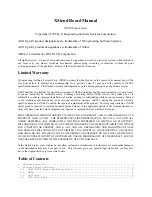
Getting Help!
If you follow the instructions in this manual and you encounter problems, here are some places to
get help:
•
If you can't get the XS Board hardware to work, send an e-mail message describing your
problem to
or check our web site at
http://www.xess.com/FPGA
.
•
If you can't get your XILINX software tools installed properly, send an e-mail message
describing your problem to
or check their web site at
http://www.xilinx.com/support/searchtd.htm
.
1
XStend Overview
The XS40 and XS95 Boards offer a flexible, low-cost method of prototyping FPGA and CPLD
designs. However, their small physical size limits the amount of support circuitry they can hold.
The XStend Board removes this limitation by providing additional support circuitry that the
XS40 and XS95 Boards can access through their breadboard interfaces.
The XStend Board contains resources that extend the range of applications of the XS Boards
into three areas:
•
The pushbuttons, DIP switches, LEDs, and prototyping area are useful for basic lab
experiments. These features in combination with the XS Boards replicates the functionality
of the older HW/UW FPGABOARD.
•
The VGA monitor interface, PS/2 keyboard/mouse interface, and static RAM let the XS
Boards be used in video and computing experiments.
•
The stereo codec and dual-channel analog input/output circuitry are useful for processing of
audio signals in combination with DSP circuits synthesized with XILINX's CORE generation
software.
2
XStend Board Features
The XStend Board extends the capabilities of the XS40 and XS95 Boards by providing
•
mounting receptacles for both an XS40 and an XS95 Board;
•
a 3"×3" prototyping area;
•
a 42×2 connector for add-on daughterboards.
•
additional LEDs and LED displays;
Summary of Contents for XStend
Page 29: ...XStend Bus Connections...
Page 30: ...XStend RAMs...
Page 31: ...XStend Analog I O...
Page 32: ...XStend Stereo Codec...
Page 33: ...XStend Switches LEDs VGA Interface and PS 2 Interface...
Page 34: ...XStend Board Layout...




































